Have you already started to learn Russian? Want to learn some Russian sentence structures and patterns? Good! Today, you’ll learn most important components of Russian sentences and learn how to make Russian sentences. Let’s start.
By the way, feel free to…
- Print this lesson for yourself
- Send it an email to a friend
- Share it with other language learners
✅ Also… if you REALLY want to learn & speak Russian, I suggest RussianPod101. You get 1,000+ audio/video courses, lessons by Russian teachers and a whole learning system. Sign up at RussianPod101 (click here) and start learning! I recommend ’em as a teacher & learner.
8 Russian Sentence Structures for Beginners
1. [A] is [B]
This is the most common Russian sentence pattern. Here, you’re just saying a basic statement like “The Apple is Red” or “I am happy.”
- [A] это [B] or [A] [B]
- Transliteration: [eto]
- Transliteration is the pronunciation or how you’d say “это” out loud.
The verb “is” is almost never used in the Russian language. To say [A] is [B] (adjective and a noun), we can just say [A] [B] (adjective and a noun). To say [A] is [B] (verb and an adverb), just say [A] это [B].
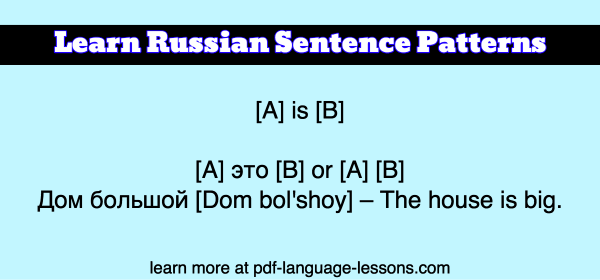
Here are some examples for you:
-
Кошки это животные [koshki eto zhivotniye]– The cats are animals.
- Note, this follows the [A] это [B] pattern. Again, это (pronounced eto) means is the verb “is/are.”
- Я парень [ya paren’] – I’m a guy
- This is [A] [B]
- So, in Russian, you’re literially saying “I guy.”
- Машина большая [Mashina bol’shaya] – The car is big.
- [A] [B]
- In Russian, you’re literally saying “Car big.”
- Веселиться это хорошо [Veselit’sya eto horosho] – It’s good to have fun.
- [A] это [B]
- Eto is back. Here, you’re saying Having Fun is Good.
- Дом большой [Dom bol’shoy] – The house is big.
- [A] [B]
- In Russian, it’s like saying “House big.”
Now that you learned this Russian pattern, here’s something you should know. In Russian, the position of the words in the sentence is not important. Although you learned that the pattern is [A] [B], [B] can come before [A] too and still mean the same. In fact, you can have 8 different variations…
- Сегодня собака поймала кота.
- Cобака поймала кота сегодня.
- Поймала собака кота сегодня.
- Сегодня собака кота поймала.
- Собака кота поймала сегодня.
- Поймала кота собака сегодня.
- Кота поймала собака сегодня
- Кота собака поймала сегодня
…and the meaning is the same: Today the dog caught a cat. It’s just an example how one sentence can be transformed and how the words can be arranged.
2. Is [A] [B]? (How to ask questions in Russian.)
- [A] это [B]?
- Transliteration: [eto]
If you want to ask if “[Subject] is [B],” you don’t have to do anything new. Just make the question intonation or put a question mark at the end of the first example.
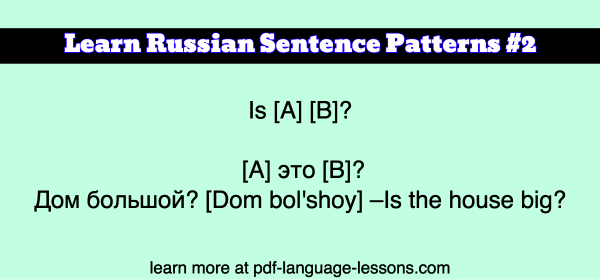
Examples of these Russian Sentence Patterns:
- Кошки это животные? [koshki eto zhivotnie]– Are the cats animals?
- Я парень? [ya paren’] – Am I a guy?
- Машина большая? [Mashina bol’shaya] – Is the car big?
- Веселиться это хорошо? [Veselit’sya eto khorosho] – Is it good to have fun?
- Дом большой? [Dom bol’shoy] –Is the house big?
3. [A] is not [B]. How to say something is NOT something in Russian.
- [A] не [B]
- Transliteration: [ne]
If we want to say [A] is not [B], we have to add {ne} before the verb – [A] не [B].
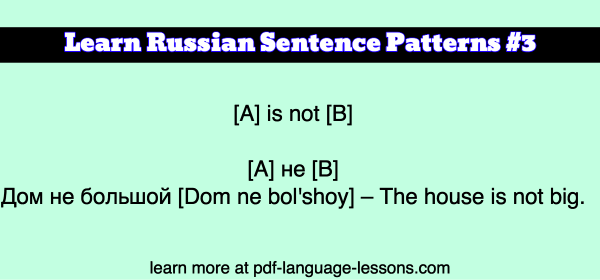
Examples of these Russian Sentence Structures:
- Кошки это не животные [koshki eto ne zhivotniye] – Cats are not animals.
- Я не парень [ya ne paren’] – I’m not a guy
- Машина не большая [Mashina ne bol’shaya] – The car is not big.
- Веселиться это не хорошо [Veselit’sya eto ne khorosho] – It’s not good to have fun.
- Дом не большой [Dom ne bol’shoy] – The house is not big.
4. How much is [A]?
- Сколько стоит [A]?
- Transliteration: [skolko stoit [A]]
If you want to ask how much is [A]?, you have to say “Сколько стоит [A]?”
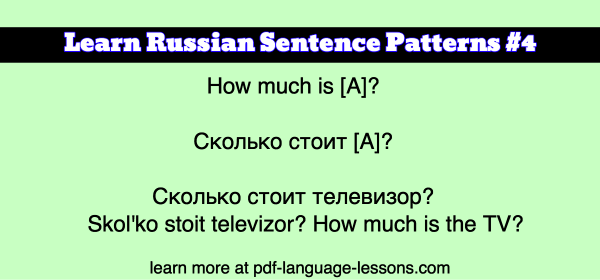
Examples:
- Сколько стоит телевизор?
- Skol’ko stoit televizor? How much is the TV?
- Сколько стоит этот поддержанный автомобиль?
- [Skol’ko stoit etot poderzhanniy avtomobil’?] – How much does this used car cost?
- Знаешь ли ты сколько стоит новый телевизор?
- [Znayesh’ li ty skol’ko stoit noviy televizor?] – Do you know how much a new TV costs?
5. It’s [A] o’clock. Saying the time in Russian.
- Сейчас [A] часов
- Transliteration: [sechas] [A] [chasov]
If you want to say what time it is, you have to use this structure “Сейчас [A] часов”. To do this you surely have to learn some Russian numbers.
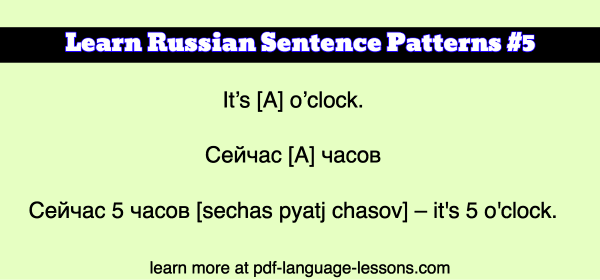
Examples of Russian sentence patterns:
- Сейчас 5 часов [sechas pyat’ chasov] – it’s 5 o’clock.
- Сейчас 6 часов [sechas shest chasov] – it’s 6 o’clock
If you want to ask “What time is it now?” ask “Который час?” [kotoriy chas?].
6. I want [A]/I want to do [A]. How to say what you want to do in Russian.
- Хочу [A]
- Transliteration: [Hochu]
If you want something, say [Hochu] and add a subject or an action. In the Russian language, you can use this word regardless if you want an object or you want to do a verb. If you want to do something, it sounds the same hochu [A].

Examples of Russian sentence structures:
- Хочу есть [hochu yest’] – I want to eat.
- Хочу велосипед [hochu velosiped] – I want a bicycle.
- Хочу выйти [chochu viyti] – I want to leave.
7. I like [A]. How to say you like something in Russian.
- Люблю [A]
- Transliteration: [Liubliu]
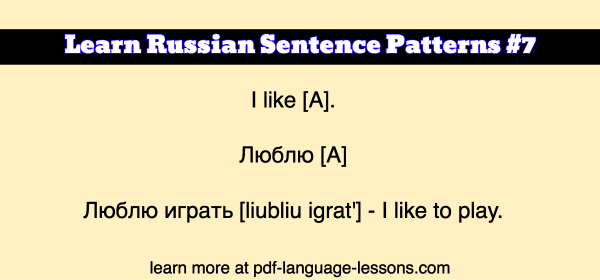
If you want to say [I like something] just say “Люблю” and add a subject or an action.
Examples of Russian sentence structures:
- Люблю играть [liubliu igrat’] – I like to play.
- Люблю свою машину [liubliu svoyu mashinu] – I like my car.
8. I can do [A]. How to talk about ability in Russian.
- Могу [A]
- Transliteration: [Mogu] [A]
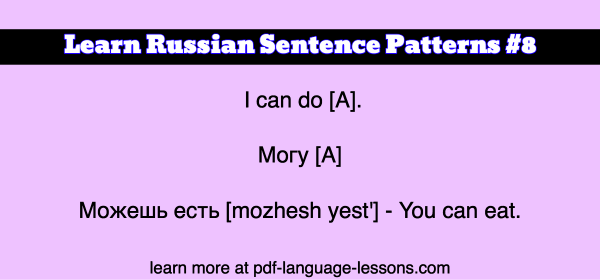
If you want to say “I can A” just say “Могу” and add a subject or an action.
Examples of Russian sentence structures:
- Могу идти [mogu idti] – I can go.
- Можешь есть [mozhesh yest’] – You can eat.
- Мы можем играть [my mozhem igrat’] – We can play.
And you’re done! These are the most used Russian sentence structures. To complete a good sentence you have to know them and learn some new words. Try to understand them, it’s great to get closer to Russian grammar. So, what should you do now?
- Get some ideas what you want to say;
- Learn some Russian words (get a dictionary);
- plug them into A and B.
 Are you interested in the Polish language? Check out a beginner lesson below:
Are you interested in the Polish language? Check out a beginner lesson below:
Good luck!
– PDF Jeff
P.S. By the way, if you want to learn Russian with a complete learning program, I suggest RussianPod101. Why? Tons of audio/video lessons that you can learn at your own pace. Free lessons every week. It’s a great, easy-to-learn program for anyone that wants to start speaking, reading and understanding Russian.
Click Here to visit RussianPod101 and check it out for yourself.
